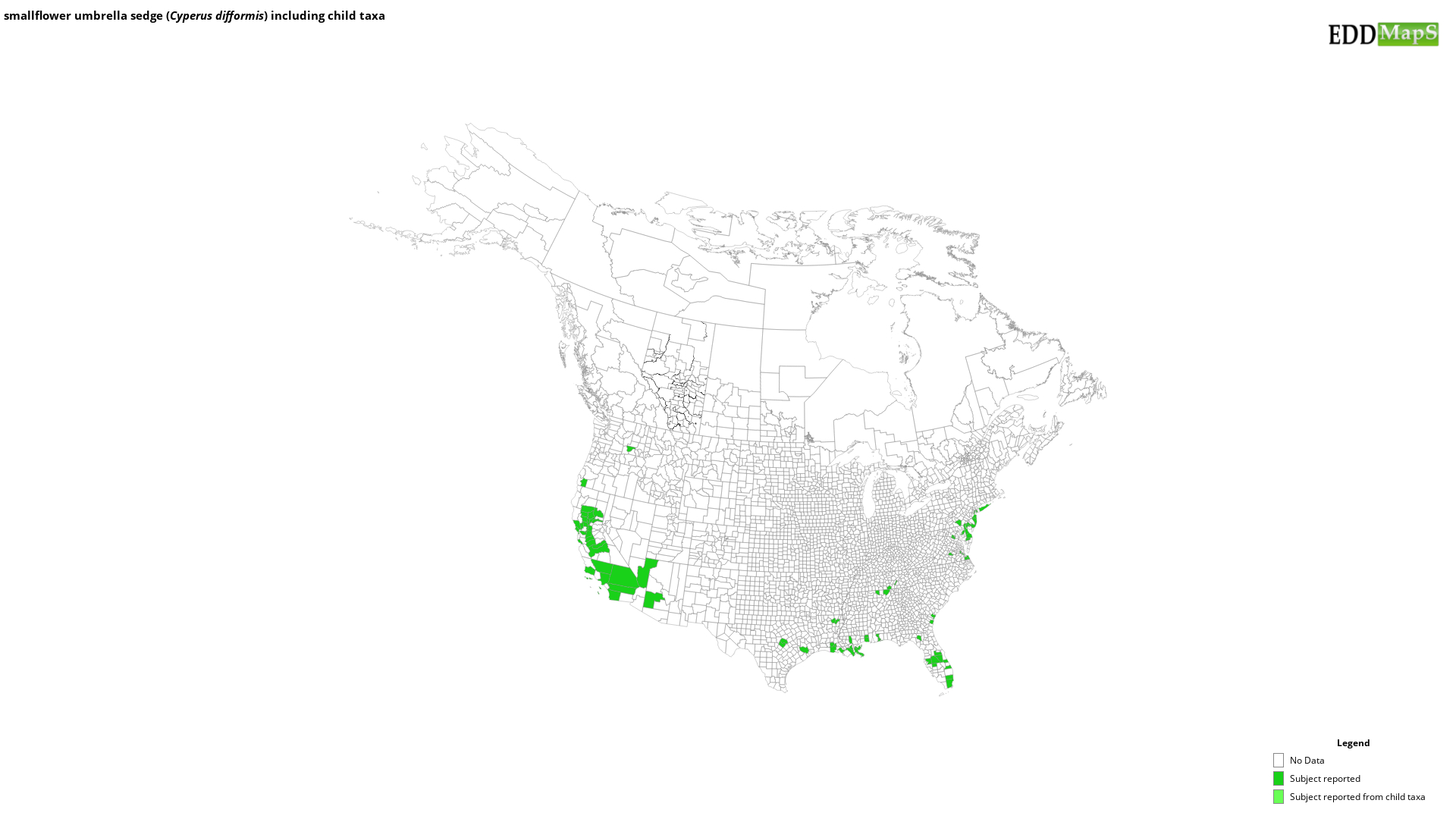smallflower umbrella sedge
(Cyperus difformis)
This species is Introduced in the United States
ORIGIN: Africa, Asia, Australia, Europe
GROWTH TRAITS: Annual, aquatic sedge growing 3-32" (7.5-81 cm) tall from a fibrous root system. Stems are, smooth, erect, slightly winged, triangular in cross-section, and up to 0.12" (3 mm) thick. Leaves are basal, flat, linear, generally up to 2/3 the length of the stems, and up to 0.25" (6 mm) wide. Leaves are typically smooth but may be slightly rough along their center or margins. Inflorescences are loose umbels with numerous globular clusters of 10-60 spikelets. Flowers are green at first but mature to brown. Beneath each inflorescence are 1-4 leaf-like bracts that are angled away from plant stems. Bracts are 10" (25 cm) long and resemble stiff leaves. Flowers are followed by small, triangular fruits ('nuts') that mature to light brown. Plants can complete their life cycle from seed to seed within a month. In warm climates, seed production continues year-round; in temperate areas, seed production is restricted to spring through fall.
REPRODUCTION: Spreads by seed. Seeds may remain viable in the soil for many years.
HABITAT: Variable flatsedge is a weed of wet and boggy areas and can grow in shallow water, including wetlands and along the margins of lakes and rivers. Plants can also invade upland areas with moist soil and grow best in full sun.
LOOK-ALIKES: The triangular stems, non-showy green flowers that mature to brown, and nut-like fruit are all characteristic of the sedge family and help differentiate variable flatsedge and other sedges from similar, unrelated species. There are several native and exotic Cyperus species present in the USA which resemble variable flatsedge in their immature stages. Variable flatsedge can be differentiated during flowering by its globular, tightly packed clusters of 10-60 spikelets. Other Cyperus species, such as the native drain flatsedge (Cyperus eragrostis), have non-spherical clusters or their spikelets are fewer in number.
CITATIONS:
Rawlins, K.A., R.L. Winston, C.T. Bargeron, D.J. Moorhead, and R. Carroll. 2018. New Invaders of the Northeast and Northcentral United States. USDA Forest Service, Forest Health Assessment and Applied Sciences Team, Morgantown, West Virginia. FHTET-2017-04. Retrieved from https://bugwoodcloud.org/resource/pdf/FHTET-2017-04_New%20Invaders_NE.pdf
GROWTH TRAITS: Annual, aquatic sedge growing 3-32" (7.5-81 cm) tall from a fibrous root system. Stems are, smooth, erect, slightly winged, triangular in cross-section, and up to 0.12" (3 mm) thick. Leaves are basal, flat, linear, generally up to 2/3 the length of the stems, and up to 0.25" (6 mm) wide. Leaves are typically smooth but may be slightly rough along their center or margins. Inflorescences are loose umbels with numerous globular clusters of 10-60 spikelets. Flowers are green at first but mature to brown. Beneath each inflorescence are 1-4 leaf-like bracts that are angled away from plant stems. Bracts are 10" (25 cm) long and resemble stiff leaves. Flowers are followed by small, triangular fruits ('nuts') that mature to light brown. Plants can complete their life cycle from seed to seed within a month. In warm climates, seed production continues year-round; in temperate areas, seed production is restricted to spring through fall.
REPRODUCTION: Spreads by seed. Seeds may remain viable in the soil for many years.
HABITAT: Variable flatsedge is a weed of wet and boggy areas and can grow in shallow water, including wetlands and along the margins of lakes and rivers. Plants can also invade upland areas with moist soil and grow best in full sun.
LOOK-ALIKES: The triangular stems, non-showy green flowers that mature to brown, and nut-like fruit are all characteristic of the sedge family and help differentiate variable flatsedge and other sedges from similar, unrelated species. There are several native and exotic Cyperus species present in the USA which resemble variable flatsedge in their immature stages. Variable flatsedge can be differentiated during flowering by its globular, tightly packed clusters of 10-60 spikelets. Other Cyperus species, such as the native drain flatsedge (Cyperus eragrostis), have non-spherical clusters or their spikelets are fewer in number.
CITATIONS:
Rawlins, K.A., R.L. Winston, C.T. Bargeron, D.J. Moorhead, and R. Carroll. 2018. New Invaders of the Northeast and Northcentral United States. USDA Forest Service, Forest Health Assessment and Applied Sciences Team, Morgantown, West Virginia. FHTET-2017-04. Retrieved from https://bugwoodcloud.org/resource/pdf/FHTET-2017-04_New%20Invaders_NE.pdf
Selected Images
Maps
EDDMapS Distribution - This map is incomplete and is based only on current site and county level reports made by experts, herbaria, and literature. For more information, visit www.eddmaps.org
State Lists - This map identifies those states that have this species on their invasive species list or law.
Invasive Listing Sources
Taxonomic Rank
| Domain: Eukarya |
| Kingdom: Plantae |
| Phylum: Magnoliophyta |
| Class: Magnoliopsida |
| Superorder: Lilianae |
| Order: Poales |
| Family: Cyperaceae |
| Subfamily: Cyperoideae |
| Tribe: Cypereae |
| Genus: Cyperus |
| Cyperus difformis |
References
Common Name Reference: Weed Science Society of America Common Names List
Scientific Name Reference: USDA, NRCS. 2010. The PLANTS Database. National Plant Data Center, Baton Rouge, LA, USA.


